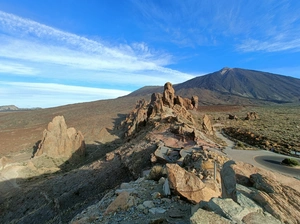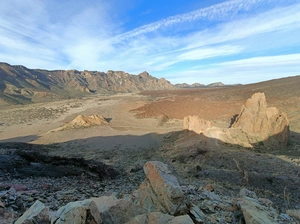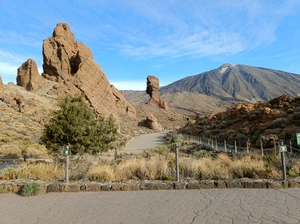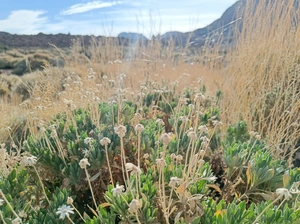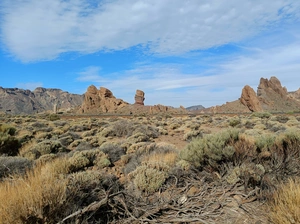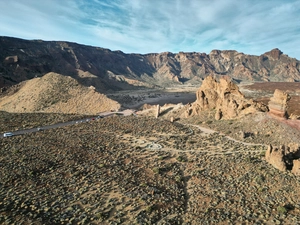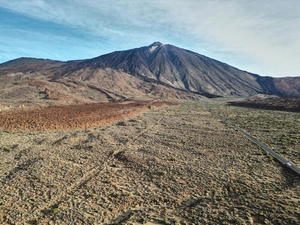Teide National Park
Find a transport route
| The meaning of the object: | Park |
| Country: | Spain |
| Archipelago: | Canary Islands |
| State District: | Santa Cruz de Tenerife |
| Town: | La Orotava |
| Alternative names of the object ⬇ | |
| Parque Nacional del Teide | |
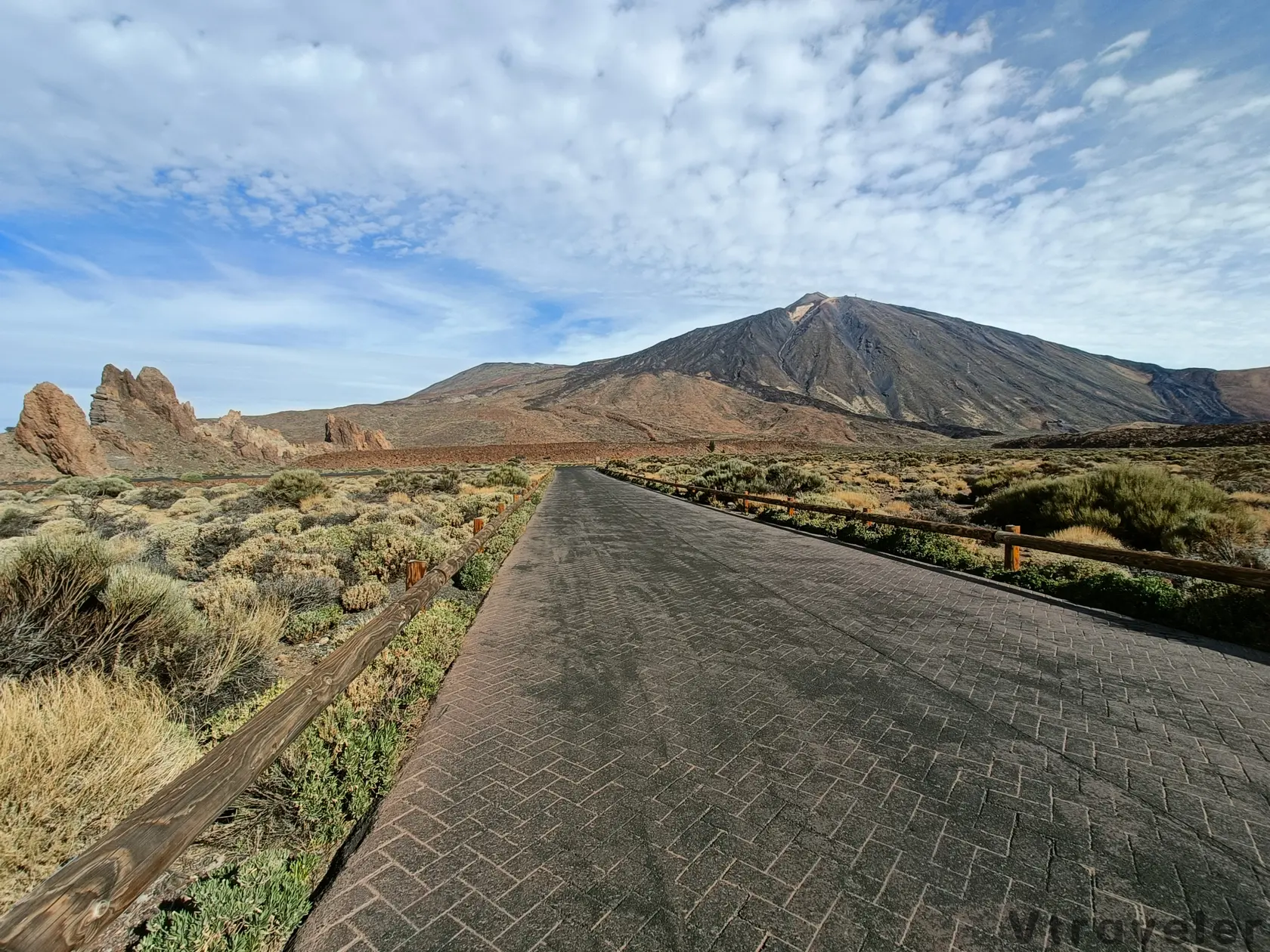
Description
Introduction
Teide National Park, located on the Canary Islands in the very heart of Tenerife, is one of the most majestic and unique natural landmarks in Spain. The park's main attraction is Mount Teide, which is not only the highest point in Spain, reaching an altitude of 3,718 meters, but also one of the highest volcanoes in the world on an island territory. Teide National Park was declared a UNESCO World Heritage Site in 2007 and attracts over 4 million visitors each year thanks to its breathtaking landscapes, unique flora and fauna, and a multitude of accessible trails for hiking and exploration.
The park covers an area of over 190 square kilometers and consists of the crater of an ancient supervolcano, forming the unique Las Cañadas caldera. This caldera is surrounded by volcanic cones, lava flows, and is covered with perse volcanic rock, creating a distinctive lunar landscape. The climate of the park varies from subtropical at the base to alpine at higher altitudes, making it an ideal place to observe temperature variations and biopersity.
Mount Teide is not only a geological gem but also a place rich in history and culture. The local Guanche aborigines considered it a sacred site and the home of the god of volcanoes. Today, Teide Park is not just a site for scientific research but also a popular destination for ecotourism, offering visitors the opportunity to see the starry sky, enjoy the sunrise over the clouds, and get acquainted with unique species of plants and animals, some of which are found nowhere else in the world.
Teide Volcano
Teide Volcano is an active volcano that dominates the landscape of Teide National Park and serves as its main attraction. With a height of 3,718 meters, Teide is not only the highest point in Spain but also the third largest volcanic cone in the world, measured from its base on the ocean floor. This colossal volcano is visible from almost all points on the island of Tenerife and is a key element in the local ecosystem and culture.
The formation of the volcano began around 170,000 years ago, and its current appearance has been shaped by successive eruptions, the most recent of which occurred in 1909. The landscape around Teide is characterized by perse volcanic formations, including flows of solidified lava, pyroclastic deposits, and lava tubes, which create a unique and awe-inspiring landscape.
The volcano itself comprises two main parts: the Pico del Teide crater and the old Las Cañadas crater, which is surrounded by dramatic slopes of the caldera. This area is often covered with snow in winter, creating a magnificent visual contrast with the fiery red and black hues of the volcanic rock.
Teide is not just a place of natural beauty but also an important scientific site. The volcano is actively monitored using modern technologies to predict possible eruptions. The persity of geological formations and altitude zones provides various types of microclimates, which support the existence of unique flora and fauna species, including endemic ones such as the Canary Island pine and broom.
This volcano is a popular destination for tourism and scientific expeditions, offering routes for hiking, mountaineering, and photography. Climbing Teide is a journey through various landscapes, from fertile forests to the lunar landscapes of the highlands, and provides a unique opportunity to see the world from one of the highest points in the Atlantic Ocean.
Legends
Teide National Park is not only a place of incredible natural beauty but also a cradle of numerous legends and myths that have been passed down from generation to generation among the indigenous people of the Canary Islands — the Guanches. The volcano Teide, or as the aborigines called it, "Echeyde," which means "hell" or "fiery mountain," occupies a central place in these tales. The Guanches considered this volcano sacred and the home of their mighty god Guayota, the god of fire and light, who ruled over volcanoes and fire.
The Legend of Guayota and Achamán
One of the most famous legends tells of the fire god Guayota and the goddess of the sky and water, Achamán. Guayota, sometimes personified as the volcano Teide itself, imprisoned Achamán in the enormous crater. According to the legend, this led to a struggle between the heavens and the earth, where Achamán tried to free herself, causing rains and storms. Guayota, in turn, responded with eruptions and flows of lava. These mythological events explained natural phenomena to the aborigines, such as volcanic eruptions and changes in weather.
The Legend of Magma and Echeyde
Another legend tells of Magma, the spirit that lives in the very heart of Teide. Magma was in love with a beautiful Guanche princess named Echeyde. However, their love was forbidden by the tribal chief. To be together, Magma transformed into a huge pillar of fire that lifted Echeyde into the heavens, creating what we now see as the volcano Teide. This story symbolizes eternal love and passion, which are as untameable as the volcano itself.
The Legend of the Sun Crystal
Another popular legend is related to the stones and minerals that can be found in Teide National Park. It is said that within the depths of the volcano lies the Sun Crystal — a magical stone that possesses unlimited energy and the ability to control time. Many travelers and adventurers have tried to find this crystal, but the volcano protects its treasure, creating complex labyrinths of lava and stone.
The Legend of the Dragon and the Gates of Fire
The legend says that in ancient times, a dragon decided to make Teide its home. It dug its lair in one of the volcanic cave complexes, which later became known as the Gates of Fire. The entrance to these gates is guarded by fire spirits, and only the worthy can pass through them. This legend illustrates the struggle between light and darkness and serves as a reminder of the power and mystery of Teide.
These myths and legends give Teide National Park a special charm, making it not just a place of beautiful landscapes but also a space filled with deep cultural and historical layers. Visitors to the park can feel the connection of times and cultures, exploring these places and breathing in the spirit of ancient legends that live in every corner of this amazing and sacred place.
What to See
Teide National Park offers a multitude of unique attractions, each representing not just natural beauty but also revealing new aspects of the island's history and geology. Visiting these places provides a deep understanding of the uniqueness and persity of Tenerife's landscapes.
Roque Cinchado
One of the most photogenic and iconic spots in Teide National Park is Roque Cinchado — an amazing group of rock formations located in close proximity to the Teide volcano. These unique volcanic formations, shaped by erosion, appear as standalone stone pillars, sometimes referred to as "stone trees." Roque Cinchado is known for its distinctive contours and is one of the symbols of Tenerife, often depicted on postcards and in travel guides.
Pico Viejo
Pico Viejo, the second highest peak on Tenerife after Teide, reaches 3135 meters above sea level. This volcano, with a deep crater about 700 meters in diameter, offers visitors the opportunity to see the traces of its last eruption in 1798. Lava flows and pyroclastic deposits here create magnificent, multicolored landscapes, providing a unique opportunity to study volcanic activity and its consequences.
Caldera de las Cañadas
Caldera de las Cañadas is a massive caldera in the center of Tenerife, estimated to be about 150,000 years old. This impressive caldera, surrounded by dramatic cliffs, is one of the most majestic examples of caldera formations in the world. Its expansive spaces and flat bottoms offer incredible panoramic views and are the perfect place for hiking, observing geological features, and photography.
Views of the Neighboring Islands
From the peaks and many viewpoints of the park, there are breathtaking views of the neighboring Canary Islands — La Gomera, La Palma, and El Hierro. The clarity of the atmosphere and the high altitude make these views particularly picturesque, especially in the early morning or late evening hours when the sun creates a soft light and allows you to see distant horizons.
Nighttime Starry Sky
Teide National Park is known as one of the best places in the world for stargazing due to its high altitude, remoteness from city lights, and clear skies. It is home to one of the world's leading observatories, and visitors can participate in nighttime tours and stargazing sessions, which are unforgettable experiences. Astronomy enthusiasts and those who simply want to enjoy the beauty of the night sky will find ideal conditions here for observing the Milky Way, meteor showers, and other astronomical phenomena.
Roques de García
Roques de García is another complex of volcanic rocks located in the Caldera de las Cañadas. These rocks are unique geological formations with perse structures and compositions, which are the result of erosion and ancient volcanic activity. The most famous of these rocks is Roque Cinchado, but the entire complex is of interest to geologists and nature lovers. The trails around Roques de García offer easy and accessible routes for pedestrians, allowing a close look at these impressive natural sculptures.
These places in Teide National Park represent not only visual beauty but also a deep understanding of the natural processes that shaped this unique landscape. Exploring these sites gives visitors the opportunity to see and feel the Earth's history over millions of years.
Excursions
Teide National Park offers a wide range of excursions, each of which allows you to explore this unique corner of nature from different angles and at different times of the day. Thanks to the persity of landscapes and rich history, everyone will find an excursion to their taste, whether it's a solo adventure or an organized group trip.
Independent Excursions
For those who prefer to explore nature at their own pace, Teide National Park provides the opportunity for independent excursions. Visitors can choose from a variety of routes of different difficulty levels, ranging from short walks to serious hiking treks with ascents to the peak of Teide. The park has a well-developed network of trails, each well-marked and with informational signs describing the route and its features.
Group Bus Tours
For those who prefer a more comfortable and organized way to experience the park, there are group bus tours. These tours include visits to the main attractions of the park, including Roque Cinchado, the Las Cañadas caldera, and the Pico Viejo volcano. Professional guides will talk about the history, geology, and biology of the region, making each stop informative and engaging.
Quad Bike Excursions
For lovers of active recreation and adrenaline, Teide National Park offers quad bike excursions. This exciting adventure allows visitors to explore less accessible parts of the park, ride through lava fields, and enjoy panoramic views at high speeds. These tours are usually conducted under the guidance of experienced instructors who ensure the safety of all participants.
Evening Tour with a Guide
The evening tour with a guide is a unique opportunity to see Teide National Park at the most magical time of day. The excursion starts a few hours before sunset and includes visits to the most picturesque places in the park. Guides talk about the local flora and fauna, as well as the culture and legends of the island. The culmination of the tour is watching the sunset from one of the viewing platforms, where the sky and volcanic landscapes are painted in incredible colors.
Sunset Tour
The sunset tour is another option for those who want to enjoy the beauty of Teide in the peaceful atmosphere of the fading day. Sunset excursions are especially popular among photographers and romantics, as this time of day changes the day to night, creating fantastic shadows and lighting. Tour participants can see how the last rays of the sun play on the rocks and craters, and how the sky gradually fills with stars.
Star Gazing
One of the most impressive adventures in Teide National Park is stargazing. The park is one of the best places in the world for astronomy, thanks to its high altitude, clean air, and absence of light pollution. Excursions for stargazing include working with professional telescopes and lectures from astronomers, which make this experience educational and fascinating. Visitors can learn about different constellations, see planets, nebulae, and even watch meteor showers in comfortable conditions.
Observatory Visit
For those who are more deeply interested in astronomy, a visit to the Teide Observatory is offered. It is one of the largest observatories in the world, equipped with advanced telescopes and instruments for exploring space. During the tour, visitors can get acquainted with the work of astronomers, learn about current research, and even look at the Sun through special solar telescopes. The excursion to the observatory is a unique chance to see science in action and expand your knowledge of the Universe.
Each of these excursions opens up Teide National Park from a new side, allowing a deeper understanding and appreciation of its natural and cultural wealth. Regardless of the type of excursion chosen by the visitor, they are sure to receive unforgettable impressions and new knowledge.
Viewpoints
Teide National Park is abundant with viewpoints, each offering breathtaking views of the volcanic landscapes, craters, lava flows, and panoramas of the island of Tenerife. These viewpoints are ideal places for photography, observing nature, or simply for moments of tranquility and admiration of natural beauty.
Mirador de La Rambleta
Mirador de La Rambleta is located at the upper station of the Teleférico del Teide cable car and is one of the highest viewpoints in Spain. From an altitude of 3555 meters, visitors can enjoy panoramic views of the Teide volcano crater, the Las Cañadas caldera, and, in good weather, the neighboring Canary Islands. This place is especially popular with tourists who want to see the sunrise or sunset when the sky is painted in fantastic shades.
Mirador de Pico Viejo
From Mirador de Pico Viejo, there is a magnificent view of the island's second-highest peak — Pico Viejo, with its impressive crater more than 700 meters in diameter. This viewpoint is located on the trail leading to the summit of Pico Viejo and offers panoramic views of the southern part of the island, including resorts and the coastline. On clear days, not only La Gomera and La Palma can be seen, but also El Hierro in the distance.
Mirador de Chío
Mirador de Chío is one of the most accessible viewpoints, located on the western side of the park. It offers a broad view of the volcanic landscape, including a series of smaller volcanoes and lava fields. This viewpoint is particularly popular among geologists and anyone interested in volcanic processes, as it provides a clear view of various types of lava and volcanic formations.
Mirador de Roques de García
Mirador de Roques de García is located in the heart of the park and offers one of the most iconic views of Teide National Park — of Roque Cinchado and other rocks of the Roques de García against the backdrop of the Teide volcano. This viewpoint is one of the most photographed spots in Tenerife, and it's no wonder it attracts artists, photographers, and tourists from all over the world.
Mirador de La Ruleta
Mirador de La Ruleta offers a unique view of the northeastern part of the island, including valleys and canyons leading to the ocean. This high-altitude viewpoint is ideal for those who want to see different aspects of the island's nature: from dense pine and laurel forests to the coastline and the sea.
Mirador de La Fortaleza
Mirador de La Fortaleza provides splendid views of the northern slopes of Teide and the Caldera Blanca crater. The name "La Fortaleza" (fortress) comes from the rocky formations that resemble the walls of a fortress or castle. This is a great place to observe clouds that often envelop the middle altitudes, creating impressive "waterfalls" of clouds.
Mirador Astronómico de Sámara
Mirador Astronómico de Sámara is one of the best spots for astronomical observations in the park. This viewpoint is specially equipped for nighttime stargazing and is part of the observatory's visitation program. Astronomers and stargazing enthusiasts come here to take advantage of the minimal light pollution and ideal conditions for studying the night sky.
Mirador del Teide
Mirador del Teide is one of the highest accessible points for visitors, from where a panoramic view of the entire volcanic complex and the wide expanses of the park is available. This viewpoint is ideal for those who want to feel the scale and grandeur of Teide, as well as for those looking for perfect conditions for nature photography.
Each of these viewpoints in Teide National Park offers a unique opportunity to see and appreciate the beauty and persity of landscapes that make this park one of the most visited and beloved by travelers from around the world.
Things to Do
The variety of activities in this unique volcanic region makes each visit unforgettable. From hiking trails to astronomical observations — everyone will find an activity to their taste.
Hiking Trails
One of the most popular activities is hiking along the numerous trails. The routes vary from easy walks to serious climbs, allowing nature enthusiasts of all skill levels to enjoy the magnificent landscapes. A walk along the trail to the peak of Pico Viejo offers panoramic views of the volcano's crater and lava fields. For those who prefer less demanding routes, the path around Roques de García provides an opportunity to see the famous rock formations and the panorama of the volcanic caldera.
Altavista Refuge
For more experienced travelers, a hike to the Altavista Refuge is a real adventure. This refuge, at an altitude of 3270 meters, offers the opportunity to spend the night on the volcano and witness the sunrise above the clouds. The route to the refuge is well-marked and takes several hours of walking, requiring good physical fitness and acclimatization to the altitude.
Mount Guajara
Trekking to the summit of Mount Guajara, the third highest point on the island (2718 m), offers dramatic views of the volcanic caldera and, in good weather, the eastern and central parts of the island. The route starts from the parking area on the Las Cañadas plateau and leads through perse landscapes, opening up new perspectives on the overall scenery.
Recreation and Barbecue Areas
For those who prefer a more relaxed rest, the region is equipped with special recreation areas with picnic tables and barbecue spots. One such popular area is La Laja, where you can have a picnic among the pine forest, enjoying the fresh air and the quiet of nature. Other areas, including Zona Acampada Chío and Área Recreativa Ramón el Caminero, also offer excellent conditions for a day of relaxation in nature.
Chinyero Volcano
Visiting the Chinyero Volcano offers a chance to see one of the last eruption sites on the island in 1909. Walking in this region allows you to explore young lava flows and volcanic cones, as well as learn more about volcanic activity and monitoring methods.
Star Gazing
Thanks to some of the cleanest skies in the world, the region is an ideal place for astronomy. Star gazing can be organized independently by choosing a dark spot on the plateau, or by joining organized tours with professional astronomers. These tours include the use of telescopes to observe planets, stars, and galaxies, as well as lectures about space.
Visit to the Observatory
For those interested in space science, visiting one of the observatories on the volcano's peaks provides an opportunity to see modern telescopes and learn about the latest astronomical discoveries. Tours to the observatory usually include a demonstration of telescope operation and an overview of current research in astronomy.
Bicycle Routes
For cycling enthusiasts, the region offers several routes with varying levels of difficulty. You can ride a bicycle on flat roads around the caldera or on more demanding mountain trails. This is an excellent opportunity to combine physical activity with the enjoyment of nature.
Photography and Painting
The amazing landscapes of the volcanic region attract many artists and photographers. Here you can find unique perspectives for shooting — from majestic peaks and monochrome lava fields to endemic plant species and dynamic clouds. Sunrises and sunsets are especially popular for creating impressive photographs and paintings.
Each of these activities helps to deepen the understanding and appreciation of the persity and beauty of this volcanic region, making every visit here truly unique and memorable.
Hotel Parador de las Cañadas del Teide
The Hotel Parador de las Cañadas del Teide is a unique place to stay, located in one of the most picturesque corners of Tenerife. This hotel offers its guests not only comfort and quality service, but also a direct immersion in the splendour of the volcanic landscape that surrounds it on all sides.
Location and architecture
The Parador Hotel is located at an altitude of about 2000 metres above sea level, making it an ideal base for exploring the local flora and fauna, as well as for hiking and cycling along the many trails. The hotel's architecture blends harmoniously with the surrounding landscape, combining traditional Canarian motifs with modern design elements. The hotel's large windows and terraces offer mesmerising views of the volcanic formations and skyline.
Facilities and amenities
The hotel offers a variety of facilities including comfortable rooms with panoramic mountain views, a restaurant with local specialities and a bar where you can relax after the day's adventures. Each room has everything you need for a comfortable stay, from a modern bathroom to satellite TV and free Wi-Fi.
The hotel's restaurant is renowned for its traditional Canarian dishes made with local ingredients, including the famed 'papas arrugadas' potatoes and various types of fresh fish. The buffet breakfast offers a wide range of dishes to suit all tastes.
Recreational opportunities
For guests seeking an active holiday, the Parador de las Cañadas del Teide Hotel offers many options. Hiking trails of varying difficulty can be taken advantage of, as well as bicycle hire to explore the surrounding area. Astronomical observing is another popular activity that allows guests to see the starry sky in all its glory, especially on specialised tours with professional guides.
Environmental Initiatives
The hotel is engaged in a number of environmental initiatives aimed at minimising environmental impact and preserving the unique volcanic landscape. In particular, there are active efforts to reduce the use of plastic, manage waste and utilise renewable energy, making a stay at the hotel not only comfortable but also responsible.
The perfect place for privacy and inspiration
The Parador de las Cañadas del Teide is not just a hotel, but a place where you can temporarily forget the hustle and bustle of everyday life and immerse yourself in the silence and beauty of the high mountain landscapes. It is the ideal place for artists, writers, photographers and anyone seeking solitude and inspiration in the embrace of nature.
All in all, the Parador de las Cañadas del Teide Hotel is not just a place to stay, but a complete centre for exploring, relaxing and enjoying all that this magnificent volcanic region has to offer. It provides a unique opportunity to experience adventure by day and enjoy cosiness and comfort at night.
How to get there
To explore the magnificent volcanic landscapes and enjoy the natural beauty, there are various ways to reach the central part of this amazing region, including travelling by bus and by car. Depending on your location in Tenerife, you can choose the most convenient option.
By bus
Travelling by bus is an economical and eco-friendly way to reach the main tourist spots. The following routes can be used:
1. Bus 348: This route starts in Puerto de la Cruz and passes through El Botánico and La Orotava, where you can see traditional Canarian homesteads and rich vegetation. The bus then follows through Aguamansa, allowing passengers to enjoy views of mountain slopes and forests, and reaches El Portillo. The final stop on the route is the Parador de Turismo Hotel in Las Cañadas, making it an excellent choice for those planning to start their adventure right from the heart of the volcanic region.
2. Bus 342: Departing from Costa Adeje, this bus passes through the resorts of Los Cristianos and Arona, offering passengers beautiful views of the south coast. The route then leads through La Escalona and Vilaflor, the highest settlement on the island, a unique opportunity to see the changes in landscape and vegetation with increasing altitude. The bus then reaches the Parador de Turismo, passing through the picturesque Las Cañadas, El Portillo Alto and the visitor centre, ending at Portillo Bajo. This route is ideal for those in the southern part of the island who want to get to the main attractions without transfers.
3. Bus 341: This route is convenient for travelling within the volcanic zone, connecting the Parador de Turismo to El Portillo Alto, the visitor centre and Portillo Bajo. It is a great choice for those who are already in the central zone and want to explore the different parts without the need for private transport.
By car
Travelling by car offers flexibility and the opportunity to explore the area at your own pace, with the option to stop at desired locations:
1. From the south of Tenerife (e.g. Costa Adeje, Los Cristianos): Start your journey from the TF-1 motorway heading towards Arona (TF-51), then continue on the TF-21 road via La Escalona to Vilaflor. This section of the road offers magnificent scenarios of countryside and colourful fields. After passing Vilaflor, the road leads through extensive pine forests and past unique volcanic formations leading to the Parador de Turismo. This route is ideal for those who love scenic roads and want to enjoy the island's perse nature.
2. From the north of Tenerife (e.g. Puerto de la Cruz): Use TF-5 southwards, changing to TF-21 via La Orotava. This road winds through fertile green valleys and vineyards before entering an area of pine forests and on to volcanic landscapes. Passing El Portillo and continuing on TF-21, you will soon reach the Parador de Turismo, which serves as an excellent starting point for further exploration of the region. This route would suit those looking for a combination of cultural and natural attractions in their journey.
Routes on the web page
-
Costa Adeje -> Lan Cañadas (how to get there)
- Puerto de La Cruz -> Las Cañadas (how to get there)
- Los Gigantes -> Las Cañadas (how to get there)
Recommendations for travellers
- Route planning: Be aware of possible weather conditions and traffic restrictions, especially during the winter months when high mountain roads may be closed due to snow or ice.
- Road safety: You should be especially careful on high mountain roads due to steep curves and possible falling rocks.
- Refuelling: Make sure your vehicle is fuelled, as petrol stations are rare in the high mountains.
- Travelling time: Leave enough time for the journey as mountain roads require slow travelling due to the difficult terrain.
Travelling to volcanic landscapes offers unique experiences and ample opportunities for exploration, making each route an adventure full of discoveries and unforgettable moments.
Opening Hours
| Monday: | Open 24 hours |
| Tuesday: | Open 24 hours |
| Wednesday: | Open 24 hours |
| Thursday: | Open 24 hours |
| Friday: | Open 24 hours |
| Saturday: | Open 24 hours |
| Sunday: | Open 24 hours |
Photos
Upload photos
Upload your photos
Videos
Watch video
Sightseeing tours and entertainment
Excursions №1
Excursions №2
Immerse Yourself in the World of Unforgettable Travels.
Discover a world of adventures and unforgettable journeys! Our website offers you unique travels, exotic tours, and unusual excursions that turn your dreams into reality. Relaxation at exotic resorts, exploration of secret corners of tropical islands, beach vacations, city tours - here you will find a variety of tours for all preferences and budgets. Perfect for search queries like "exotic travels", "tours to tropical islands", "cultural excursions", and "unforgettable adventures".
✓ Excursion Tours: Explore the cultural heritage of ancient civilizations and the beauty of picturesque nature. These excursions are an excellent choice for those looking for "adventure excursions" and "cultural tourism".
✓ Group and Individual Tours: From secluded spots for peaceful relaxation to bustling city streets – we have tours for every taste and style, from "peaceful relaxation" to "urban adventures".
✓ Guides and Tour Leaders: Our experienced guides will make your journey unforgettable, filling it with unique stories and knowledge, perfect for those looking for "tours with guides" and "excursions with a tour leader".
✓ Online Tour Booking: A simple and secure booking process on our platform ensures the protection of your personal data and convenient choice, ideally suited for queries like "online tour booking" and "secure travel booking".
✓ Deals and Special Offers: Don't miss our attractive discounts and special offers, making your vacation even more economical and memorable, ideal for searching "travel discounts" and "special travel offers".
Every trip booked through our website is the beginning of a new story, full of exciting discoveries and vivid impressions. Start your adventure today and discover the "perfect journey"!
Nearby places
What hotels are nearby
When it comes to planning travel or extended stays, choosing the right accommodation plays a key role. Booking.com offers a wide range of accommodations, including apartments, villas, flats, hostels, and especially hotels for both short-term and long-term rentals.
The service ensures that every customer finds the optimal option near the places they are interested in, whether it be beaches, famous attractions, districts, or entire cities. Booking.com's offerings cater to various tastes and budgets, providing a choice from luxury hotels to cozy apartments.
Hotel accommodation holds a special place in the company's offerings. Hotels available on Booking.com are ideal for both business trips and family vacations, offering various amenities, including restaurants, bars, swimming pools, and spas.
The catalog includes accommodation for any occasion:
- Aparthotel: A combination of apartments and hotel amenities, offering kitchens and more living space.
- Apartment: Ideal for independent travelers, offering home comforts including a kitchen and separate rooms.
- Bed and Breakfast (B&B): Cozy accommodations offering a homely atmosphere and breakfast included.
- Business Hotel: Specialized in amenities for business travelers, including conference rooms and Wi-Fi.
- Boat: A unique living experience on the water, perfect for maritime adventures.
- Camp: Simple accommodations in a natural setting, often with basic amenities.
- Camping: Spots for pitching tents or parking RVs, ideal for nature lovers.
- Capsule Hotel: Popular in Japan, offering small, functional capsules for sleeping.
- Chalet: Wooden houses in the mountains, perfect for winter holidays and ski trips.
- Country House: Offering tranquility and seclusion in the countryside.
- Cruise: Travel on a cruise liner with accommodation in cabins and onboard entertainment.
- Farm Holiday: Accommodation on working farms, offering a unique rural experience.
- Gite: Traditional French vacation homes, usually in the countryside.
- Guest House: Small, cozy houses, often family-run, offering a personal touch.
- Holiday Home: Houses or cottages for family or group vacations.
- Holiday Park: Complexes with various types of accommodation and entertainment on site.
- Homestay: Staying with local residents for cultural immersion.
- Hostel: Budget options with shared rooms and the opportunity to meet other travelers.
- Hotel: A variety of options from budget to luxury, with a wide range of amenities.
- Inn: Traditional, often historical, accommodations with personal service.
- Lodge: Often located in natural or remote areas, offering seclusion and a natural experience.
- Love Hotel: Popular in Japan, designed for short romantic stays.
- Motel: Conveniently located near roads, ideal for travelers by car.
- Resort: Accommodations with a wide range of entertainment and services on site.
- Riad: Traditional Moroccan homes with an inner courtyard, offering a unique cultural stay.
- Ryokan: Traditional Japanese inns, offering a unique experience and local cuisine.
- Villa: Often luxurious homes with privacy, ideal for family groups or large company retreats.
Customers can take advantage of flexible rental conditions, choosing accommodation for one night or an extended period. The search and booking process is greatly simplified thanks to an easy-to-use online interface, allowing you to select dates, type of accommodation, and necessary amenities.
Reasons to choose Booking.com for hotel reservations:
- A wide range of quality hotels.
- Transparent pricing without hidden fees.
- Trustworthy reviews from real customers.
- 24/7 customer support.
Thus, choosing Booking.com for hotel bookings is a decision that thousands of satisfied customers have already appreciated. Book your ideal hotel on Booking.com and enjoy a comfortable and carefree stay.
Tips:
- Budget: Determine your budget for rent or hotel stay. This will help narrow down the search to options you can afford.
- Location: Choose a convenient location for you, based on the purpose of your trip. For example, if you are traveling for tourism, choose accommodation near major attractions. For business trips, options near business centers are suitable.
- Amenities and Services: Decide which amenities are important to you. This could be Wi-Fi, a kitchen, a washing machine, or a fitness center.
- Reviews: Read reviews from other guests to learn about the real quality of the accommodation or hotel.
- Accommodation Rules: Check the accommodation rules, especially if traveling with pets or children.
- Booking and Cancellation: Check the booking conditions and cancellation policy. Some options offer free cancellation, which can be important in case of plan changes.
- Safety: Ensure the safety of the area and the accommodation itself.
- Transport: Consider the availability of public transport or parking if you are traveling by car.
Teide National Park on the map
- GPS coordinates: 28.25464000000000, -16.61545000000000
- Address: Carretera del Teide, Portillo Alto, La Orotava, Santa Cruz de Tenerife, Canarias, 38415, España
- Routes, how to get there: Route in the navigator
List of Populated places near Parque Nacional del Teide
In this section of our website, you will find a list of settlements, cities, municipalities, and villages located a short distance from Parque Nacional del Teide. Here you will find detailed information about each, including nearby hotels, tours that will reveal the historical significance, cultural features, and attractions of these places. This list of settlements will be useful for those planning to travel around the area in search of something new and who want to discover unique places located near Parque Nacional del Teide. A guide to these enchanting settlements will help you plan your travel route and enrich your experience with unique impressions.
